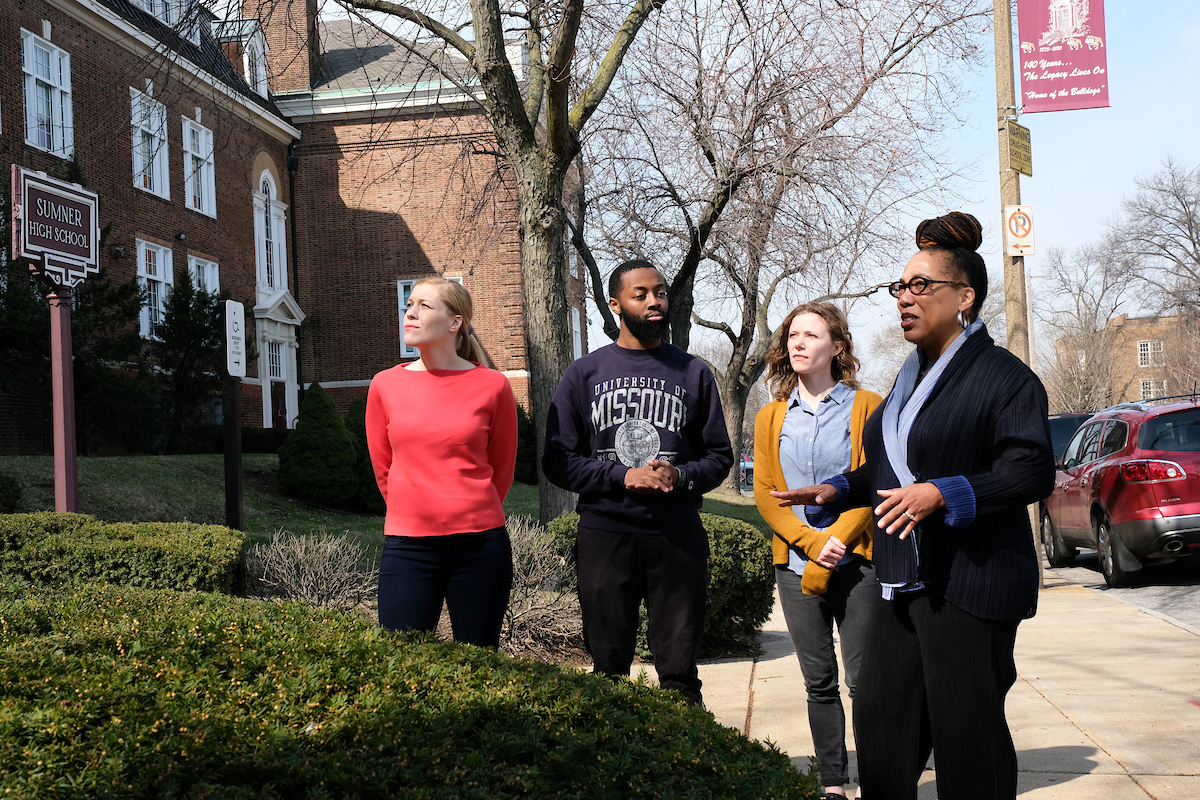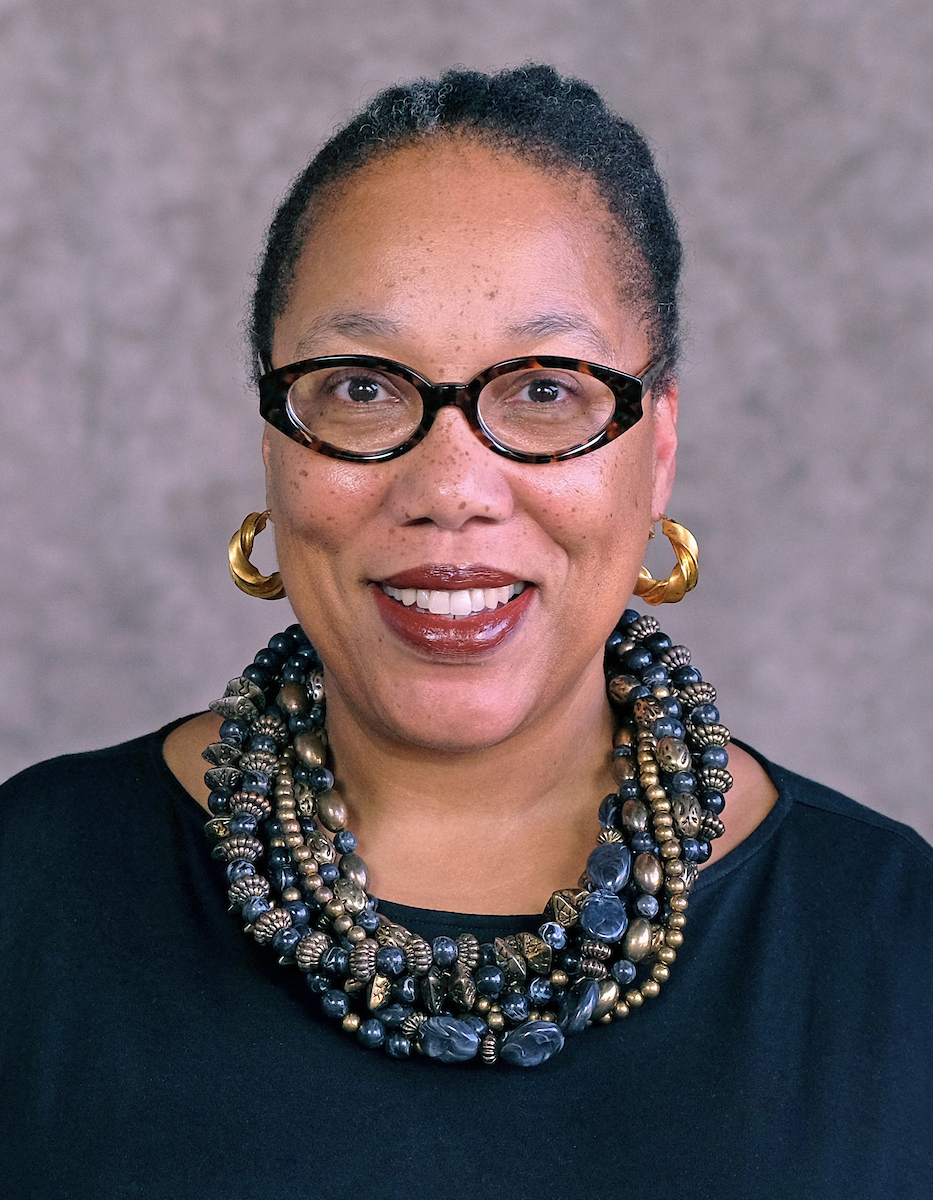
Associate Professor Priscilla Dowden-White (third from left) leads former students (from left) Michelle Radin Seymour, Brian Weaver and Cassandra Carter on a brief tour down Cottage Avenue in the Ville Neighborhood with the former Homer G. Phillips Hospital looming in the background. (Photos by August Jennewein)
Priscilla Dowden-White knows the fractures in her hometown of St. Louis have been hard to ignore in recent years. The whole country could see them in 2014 as images of civil unrest over the issue of police brutality in the aftermath of the shooting of Michael Brown in Ferguson played nightly on cable news, and they were visible again last fall after a not guilty verdict in the trial of St. Louis Metropolitan Police Department Officer Jason Stockley for a 2011 shooting.
The divisions also have manifested themselves in the inability of the region to come together on big projects, as when city voters irked many in the metropolitan area when they voted against a measure to publicly fund a downtown stadium to attract a Major League Soccer team.
More recently, St. Louis found itself excluded from a list of 20 finalists trying to land Amazon’s second headquarters, and some criticism of the region’s bid pointed to the unwillingness of officials in St. Louis County to subsidize the project at a level on par with the City of St. Louis and St. Clair County, Illinois.
“We can’t hide it,” says Dowden-White, a University of Missouri–St. Louis graduate and now associate professor of history at her alma mater. “We’re talking about how a city and how a metropolitan area views itself and its vision, where it’s going, its potential. We’ve got a long way to go in really working through those issues.”
Dowden-White can trace the origins of many divisions clearly in the city’s history – something her students come to learn well through taking her courses. Mending divisions in the present requires understanding and reckoning with that past.“
One of the larger issues that didn’t create the fracturing but that I think exacerbates it is that our city is not a part of the county,” Dowden-White says. “So some of the fracturing that major, urban cities and surrounding counties experience across the country is magnified in our area.”
Racial tension underlies many of the divisions in the St. Louis region, but it does not appear to have been the primary motivator for city residents who voted to withdraw from St. Louis County in 1876.
More likely, it had to do with taxes. The city and its 310,000 residents felt they were wasting money on about 27,000 people living in what at the time were far-flung communities such as Kirkwood and Florissant.
In a decision that continues to reverberate to this day, officials set the city’s western border at Skinker Boulevard and severed governmental ties to parts beyond it.
“I think they had an outsized inflated sense of themselves and the city,” Dowden-White says of the officials behind that decision. “In some ways it caused them to see themselves as an island unto themselves. And it hampered their ability to have vision and to look at this in the long term and to look at St. Louis as being anything other than who they were.”
Dowden-White’s real expertise lies in the often-overlooked period beginning more than three decades later. Her book “Groping toward Democracy: African American Social Welfare Reform in St. Louis” spotlights actions and events that occurred between 1910 and 1949 with consequences stretching into the present day.
Chief among them were implementation of race-restrictive covenants – agreements entered into by a group of property owners not to sell, rent or lease property to blacks or other minorities.
Dowden-White is currently at work on a biography of attorney and civil rights leader Margaret Bush Wilson. It was Wilson’s father, a real estate broker, who was the organizing force behind the 1948 U.S. Supreme Court case Shelley v. Kraemer that finally struck down the use of race-restrictive covenants.
The case originated in north St. Louis after J.D. Shelley and his family decided to fight for their right to live in housing of their choosing at 4600 Labadie Ave. The Court ruled the covenants aimed at preventing them from doing so were unenforceable under the Equal Protection Clause of the 14th Amendment.
Before then, the practice served to segregate city neighborhoods in a pattern that continues today and is visible in the so-called “Delmar Divide.”
“If you do any research on race-restrictive covenants, you’ll see that all of the race-restrictive covenants started in the first decade of the 20th Century, and it started then because that’s when the Great Migration became apparent,” says Dowden-White, referring to the migration of African Americans in the South into urban areas in the North.
The non-white population of St. Louis increased 150 percent during that period.
The concept of separate space for people of different races had previously won formal approval in the landmark Supreme Court decision in the Plessy v. Ferguson case that established the constitutionality of racial segregation in public facilities as long as the segregated facilities were equal in quality. The doctrine came to be known as “separate but equal.”
“St. Louis followed the patterns in some ways of the South in that our public schools were segregated,” Dowden-White says. “Yet our public transportation was not segregated. Blacks could go to the public library here freely.”
Dowden-White also noted that African Americans were not denied the right to vote in St. Louis the way they were throughout much of the South. That voting power could help explain why the city invested as much as it did in segregated institutions.

Former students (from left) Cassandra Carter, Brian Weaver and Michelle Radin Seymour listen intently to Priscilla Dowden-White in front of Sumner High School. “There are a lot of buildings that before her class, me and my family would just drive past, and I didn’t know anything about them,” Weaver says.
That was particularly noticeable in the historic Ville neighborhood of north St. Louis.
That’s where Sumner High School – the second oldest black public high school with a comprehensive curriculum in the United States and first west of the Mississippi River – settled in its third and current location.
It’s also where the city established Homer G. Phillips Hospital, which was the city’s public hospital designated for African Americans from its opening in 1937 until 1955, when the city’s hospitals began desegregating. It was one of the few hospitals in the country where African Americans could train as doctors and nurses.
“There are a lot of buildings that before her class, me and my family would just drive past, and I didn’t know anything about them,” says UMSL sophomore Brian Weaver, who took Dowden-White’s course on African American History: From Civil Rights to Black Power. “I didn’t know the things that transpired.”
Even after the Shelley case and other landmark decisions such as Brown v. Board of Education of Topeka, which hammered away at the principle of “separate but equal,” undoing racial segregation created in the first half of the 20th Century has proven challenging.
Race might not have been the driving force at the start of the city’s split with the county, but it could be an impediment to reunification. More affluent and largely white communities in the county seem resistant to taking on the problems in the city, where predominantly African American neighborhoods suffer from issues such as crime and lack of resources.
The county, too, remains largely segregated.
The shooting of Brown and ensuing unrest brought attention to how many municipalities in north St. Louis County used traffic tickets and other citations to profit at the expense of their poor, primarily African American residents – breeding mistrust between citizens and law enforcement in the process.
“We, of course, were surprised when Mike Brown’s murder touched off the movement that it did,” Dowden-White says. “But some of those who have studied Ferguson and our inner suburbs far more than I have, they’ve explained that we should not have been surprised that it happened.”
That’s a lesson that Dowden-White has tried to impart on all her students about the larger issue of segregation, in hopes that greater understanding might bring about change.
“It doesn’t have to be that way,” says alumna Michelle Radin Seymour, who became a history major after taking Dowden-White’s African American History course in the fall of 2015 and who completed her degree last December. “That’s why I think these classes are so important for everybody because we all need to realize that deliberate decisions were made, and this isn’t an accident. And it’s still so much a part of the fabric of St. Louis and how we view each other.”
This story was originally published in the spring 2018 issue of UMSL Magazine. Have a story idea for UMSL Magazine? Email magazine@umsl.edu.















